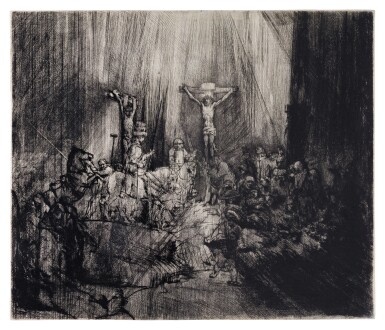Old Master & 19th Century Paintings Evening Auction
Old Master & 19th Century Paintings Evening Auction

The Property of a Distinguished Private Collector
Rembrandt Harmensz. van Rijn
Christ Crucified between the two Thieves: 'The Three Crosses'
Auction Closed
December 4, 07:09 PM GMT
Estimate
400,000 - 600,000 GBP
Lot Details
Description
The Property of a Distinguished Private Collector
Rembrandt Harmensz. van Rijn
Leiden 1606–1669 Amsterdam
Christ Crucified between the two Thieves: 'The Three Crosses'
drypoint, 1653, a fine impression of New Hollstein's fourth state (of five), displaying remarkable tonal warmth, clarity and legibility, while printing with rich burr and dramatic chiaroscuro, on laid paper
sheet: 389 x 457 mm.; 15¼ x 17⅞ in.
With a partial, faded inscription verso (probably Paul Davidsohn, London, Vienna and Berlin, cf. L. 654)
Carl and Rose Hirschler, Amsterdam and Haarlem (L. 633a)
C. White and K.G. Boon, Dutch and Flemish Etchings, Engravings and Woodcuts, Amsterdam 1969, vol. XVIII, pp. 43–44, no. 78 (other impressions illustrated);
E. Hinterding, G. Luijten and M. Royalton-Kisch, Rembrandt the Printmaker, London 2000, pp. 297-300, no. 73 (other impressions illustrated);
E. Hinterding and J. Rutgers, The New Hollstein, Dutch & Flemish Etchings, Engravings and Woodcuts: 1450–1700, Ouderkerk aan den Ijssel 2013, vol. II, pp. 222–24, no. 274 (other impressions illustrated).
You May Also Like










